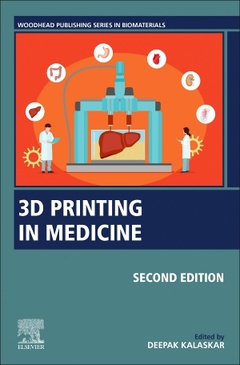Description
3D Printing in Medicine (2nd Ed.)
Woodhead Publishing Series in Biomaterials Series
Coordinator: Kalaskar Deepak M.
Language: English
Subjects for 3D Printing in Medicine:
Keywords
?3D bioprinting; 3D disease models; 3D in vitro models; 3D interconnects; 3D printed anatomical models; 3D printed guide; 3D printing; 3D printing and biomaterials; 4D printing; ASTM; Additive manufacturing; Anatomical simulation; And regulations of organ on demand; Biofabrication; Bioinks; Biomedical implants; Bioprinting; Bioresorbable implants; Bone defect repair; CEN; Cancer in vitro models; Cardiovascular models; Computational fluid dynamics; Direct-write printing; Droplet-based 3D printing
422 p. · 15.2x22.8 cm · Paperback
Description
/li>Contents
/li>Biography
/li>Comment
/li>
3D Printing in Medicine, Second Edition examines the rapidly growing market of 3D-printed biomaterials and their clinical applications. With a particular focus on both commercial and premarket tools, the book looks at their applications within medicine and the future outlook for the field. The chapters are written by field experts actively engaged in educational and research activities at the top universities in the world. The earlier chapters cover the fundamentals of 3D printing, including topics such as materials and hardware. The later chapters go on to cover innovative applications within medicine such as computational analysis of 3D printed constructs, personalized 3D printing - including 3D cell and organ printing and the role of AI - with a subsequent look at the applications of high-resolution printing, 3D printing in diagnostics, drug development, 4D printing, and much more.
This updated new edition features completely revised content, with additional new chapters covering organs-on-chips, bioprinting regulations and standards, intellectual properties, and socio-ethical implications of organs-on-demand.
1. Introduction to three-dimensional printing in medicine 2. 3D printing families: laser, powder, and nozzle-based techniques 3. Materials for 3D printing in medicine: metals, polymers, ceramics, and hydrogels 4. 3D-printed and computational models: a combined approach for patient-specific studies 5. 3D printers for surgeons practice 6. Patient-specific 3D bioprinting for in situ tissue engineering and regenerative medicine 7. 3D-bioprinted in vitro disease models 8. 3D printed pharmaceutical products 9. High-resolution 3D printing for healthcare 10. (Bio)fabrication of microfluidic devices and organs-on-a-chip 11. Four-dimension printing in healthcare 12. Present and future of standardization of additive manufacturing in the medical field 13. Social and ethical considerations of bioprinted organs 14. Medical 3D printing, intellectual property, and regulation
His research has been focused on the development of novel biomaterials and manufacturing processes to solve real-life problems in medicine. He has extensive experience in biomaterials, biocompatible coatings, 3D printing technologies, and design and development of medical devices and implants. He is working closely with several industries, clinical and academic collaborations for the development of new medical products and processes required for clinical translation. Some of his innovative 3D-printed medical devices are already used by patients. He is actively involved in running new clinical trials with various hospitals to bring 3D technologies from bench to bed side.
He is founder of the international research and educational platform supported by the British Council—the 3D Bioprinting Research Platform. The platform encourages multidisciplinary collaboration in 3D bioprinting research and education worldwide. He is the editor and author of four books in the field of 3D printing in medicine. Currently, he codirects the MSc program in Burns, Plastic and Reconstructive surgery at the University College London (UCL), to educate clinicians and scientists in translational medicine
- Reviews a broad range of biomedical applications of 3D printing biomaterials and technologies
- Provides an interdisciplinary look at 3D printing in medicine, bridging the gap between engineering and clinical fields
- Includes completely updated content with additional new chapters, covering topics such as organs-on-chips, bioprinting regulations, intellectual properties, medical standards in 3D printing, and more




